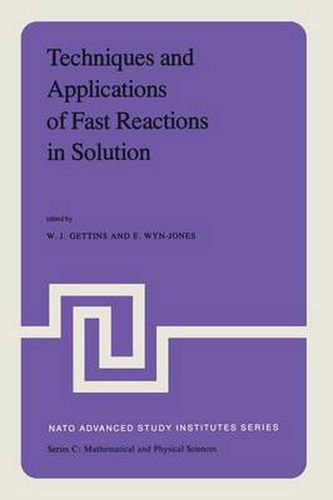Readings Newsletter
Become a Readings Member to make your shopping experience even easier.
Sign in or sign up for free!
You’re not far away from qualifying for FREE standard shipping within Australia
You’ve qualified for FREE standard shipping within Australia
The cart is loading…






This title is printed to order. This book may have been self-published. If so, we cannot guarantee the quality of the content. In the main most books will have gone through the editing process however some may not. We therefore suggest that you be aware of this before ordering this book. If in doubt check either the author or publisher’s details as we are unable to accept any returns unless they are faulty. Please contact us if you have any questions.
As a result of the pioneering efforts of Eigen, de Maeyer, Norrish and Porter, the kinetics of fast reactions in solution can now be studied using chemical relaxation methods, as well as many other fast reactions techniques. These methods have been applied successfully in many branches of the natural sciences. The simultaneous growth in the number of investiga tors and the diversity of their research interests has inevitably led to communication problems. The purpose of the NATO Advanced Study Institute entitled "New Applications of Chemical Relaxation Spectrometry and Other Fast Reaction Methods in Solution", was to create a forum so that research scientists working in different areas concerned with fast reactions could interact. This meeting was held at the Llandinam Building, University College of Wales, Aberystwyth from September 10th-20th, 1978. In addition to lectures on techniques and theory, two days of the NATO Advanced Study Institute, were spent discussing the current state of the art in this field. This two day meeting was also run under the auspices of the Chemical Society, Fast Reactions in Solution Group. The papers in this volume are the result of the contribu tions given in the Aberystwyth meeting. We have attempted to make this volume useful for the non-expert and a comprehensive introduction to theory, as well as the instrumentation used in the studies are discussed in detail.
$9.00 standard shipping within Australia
FREE standard shipping within Australia for orders over $100.00
Express & International shipping calculated at checkout
This title is printed to order. This book may have been self-published. If so, we cannot guarantee the quality of the content. In the main most books will have gone through the editing process however some may not. We therefore suggest that you be aware of this before ordering this book. If in doubt check either the author or publisher’s details as we are unable to accept any returns unless they are faulty. Please contact us if you have any questions.
As a result of the pioneering efforts of Eigen, de Maeyer, Norrish and Porter, the kinetics of fast reactions in solution can now be studied using chemical relaxation methods, as well as many other fast reactions techniques. These methods have been applied successfully in many branches of the natural sciences. The simultaneous growth in the number of investiga tors and the diversity of their research interests has inevitably led to communication problems. The purpose of the NATO Advanced Study Institute entitled "New Applications of Chemical Relaxation Spectrometry and Other Fast Reaction Methods in Solution", was to create a forum so that research scientists working in different areas concerned with fast reactions could interact. This meeting was held at the Llandinam Building, University College of Wales, Aberystwyth from September 10th-20th, 1978. In addition to lectures on techniques and theory, two days of the NATO Advanced Study Institute, were spent discussing the current state of the art in this field. This two day meeting was also run under the auspices of the Chemical Society, Fast Reactions in Solution Group. The papers in this volume are the result of the contribu tions given in the Aberystwyth meeting. We have attempted to make this volume useful for the non-expert and a comprehensive introduction to theory, as well as the instrumentation used in the studies are discussed in detail.